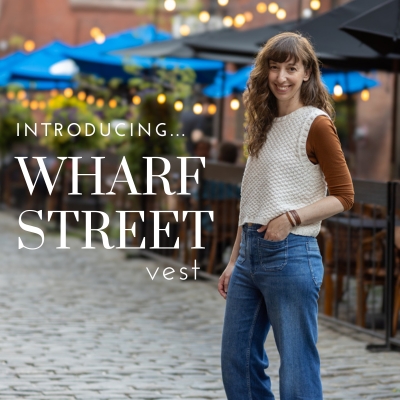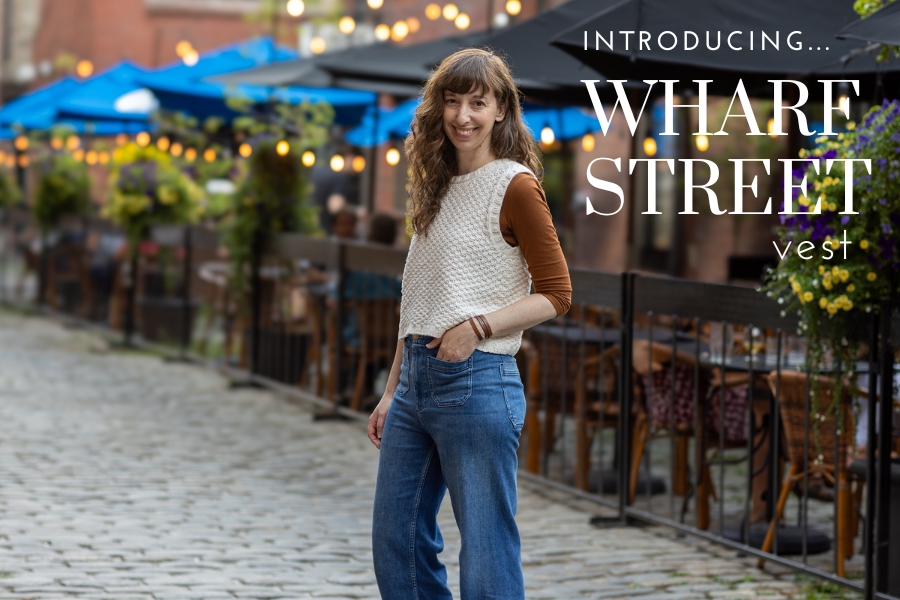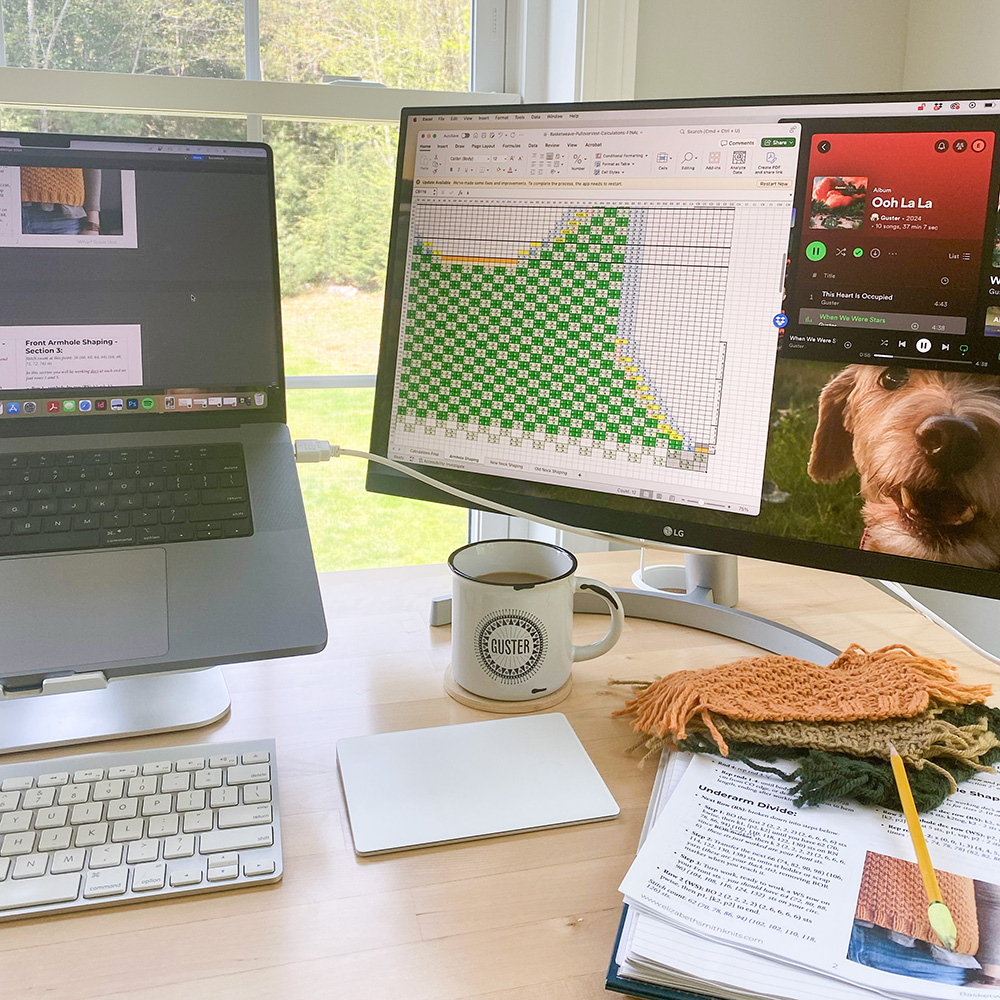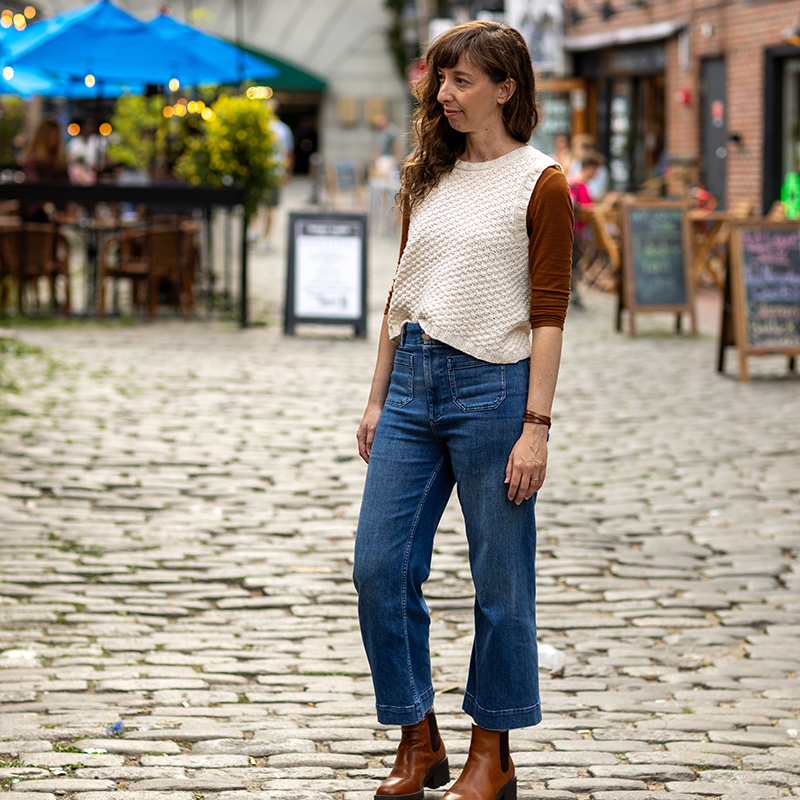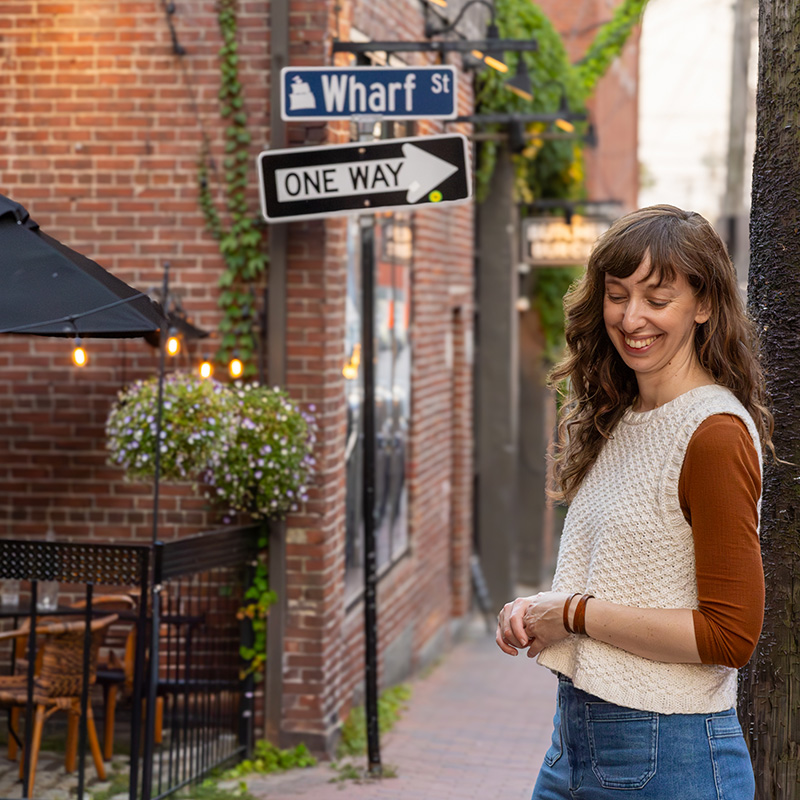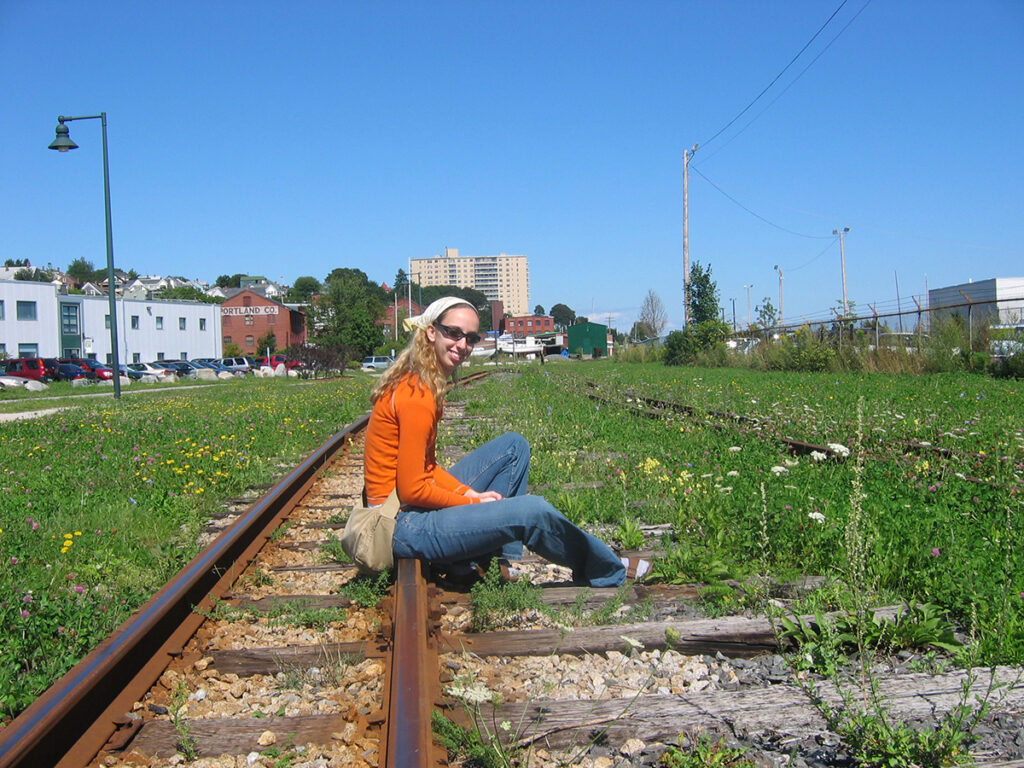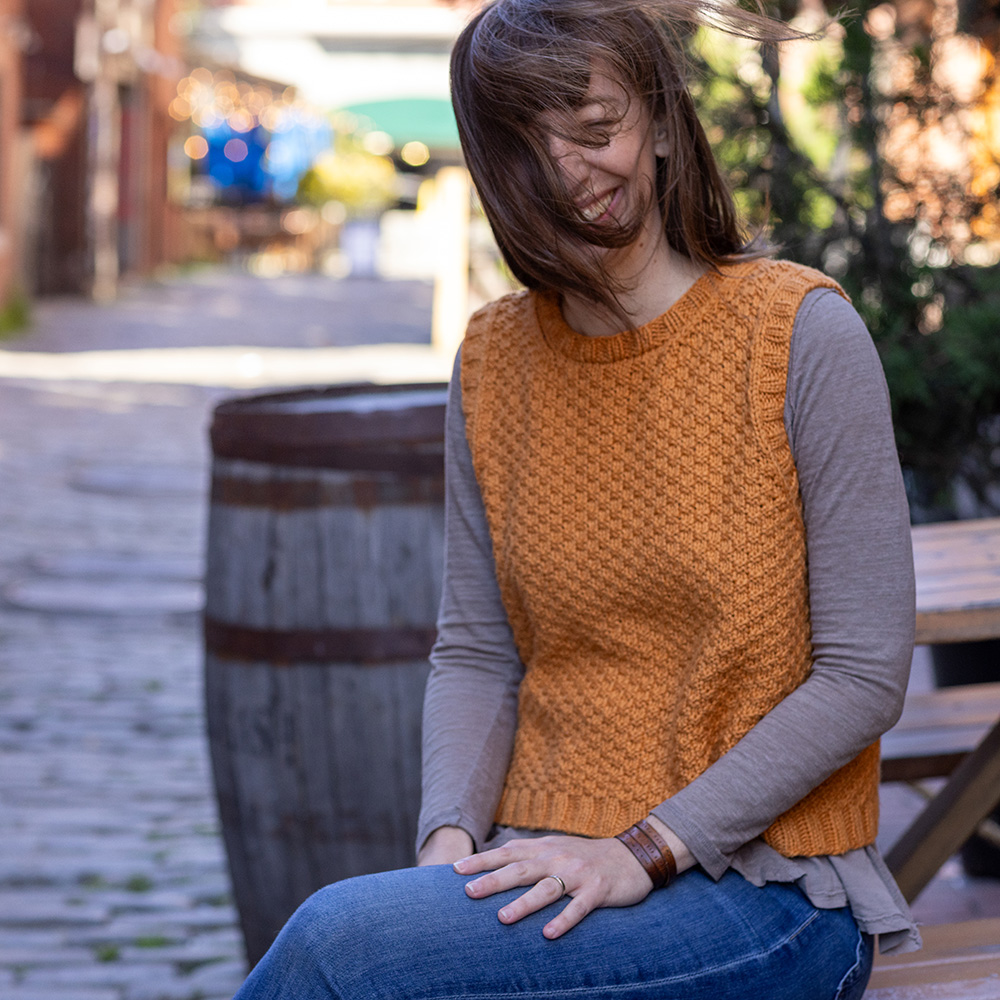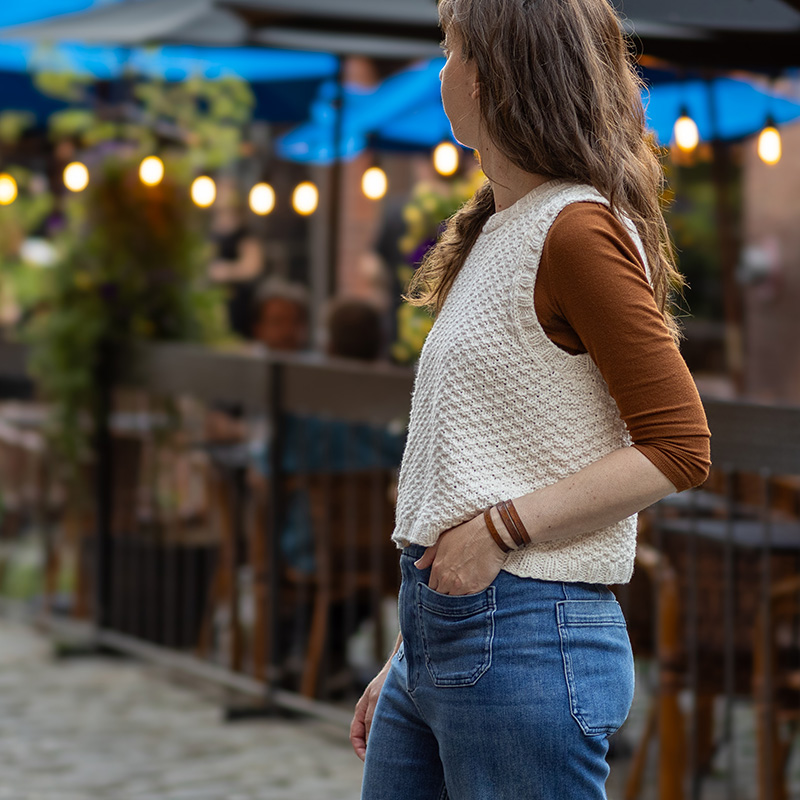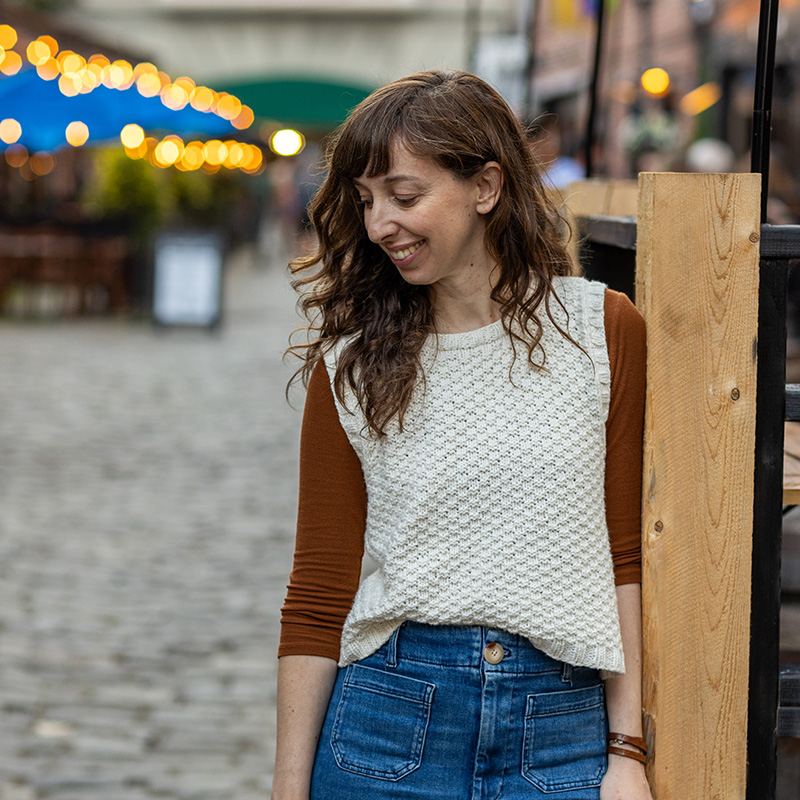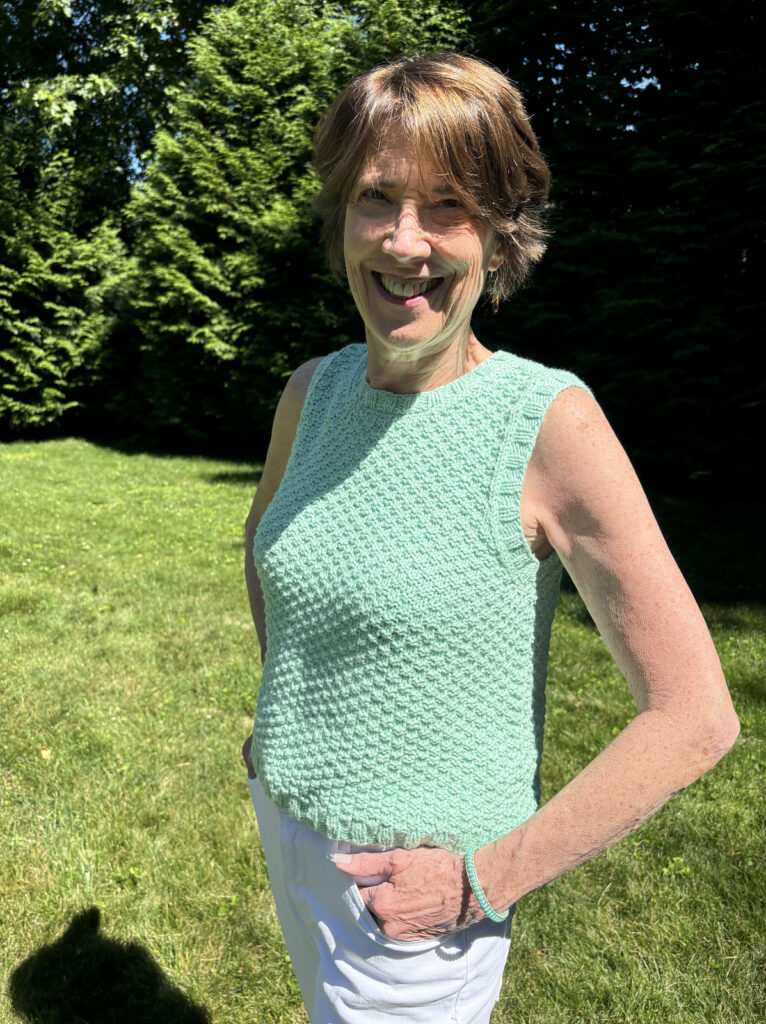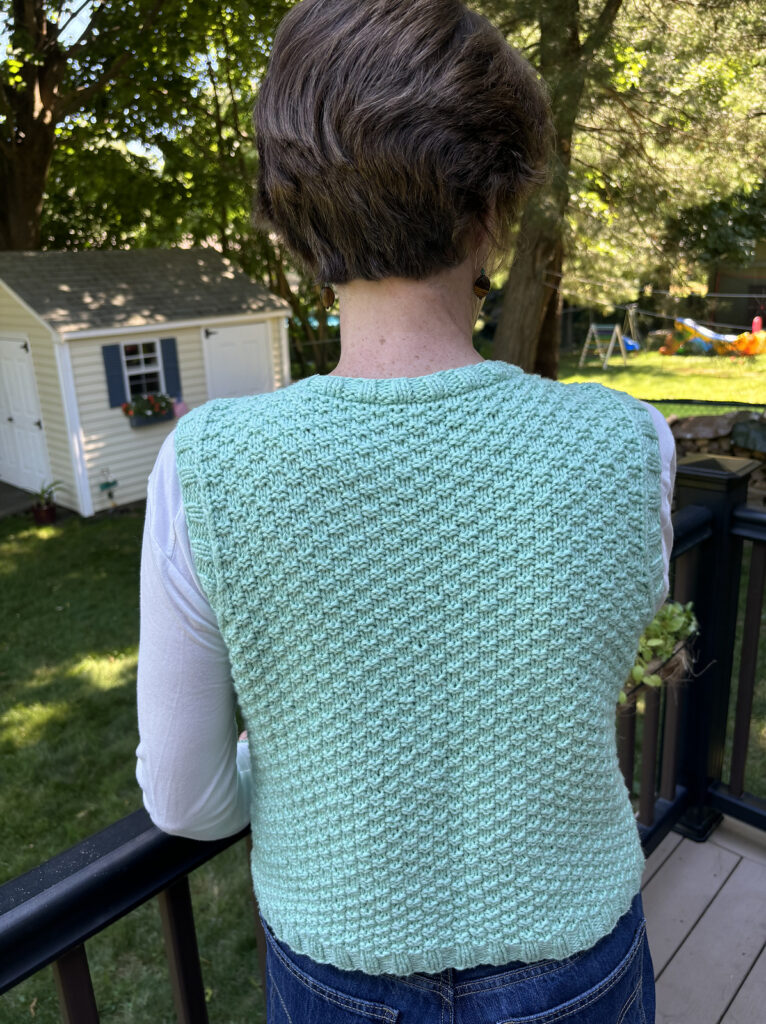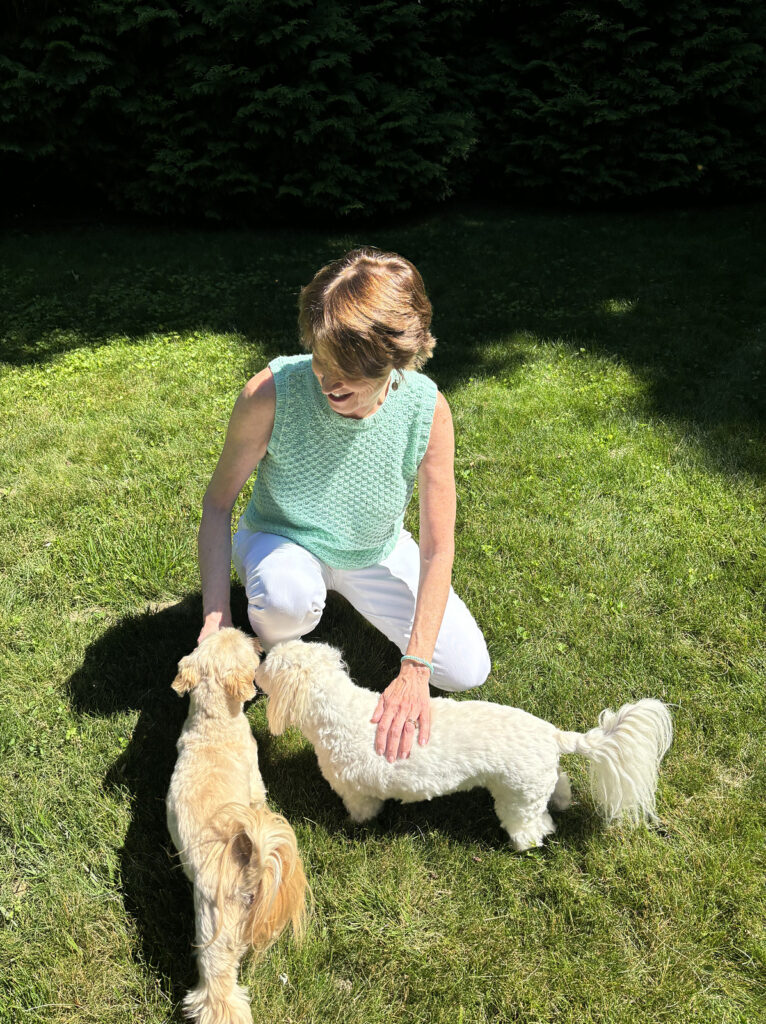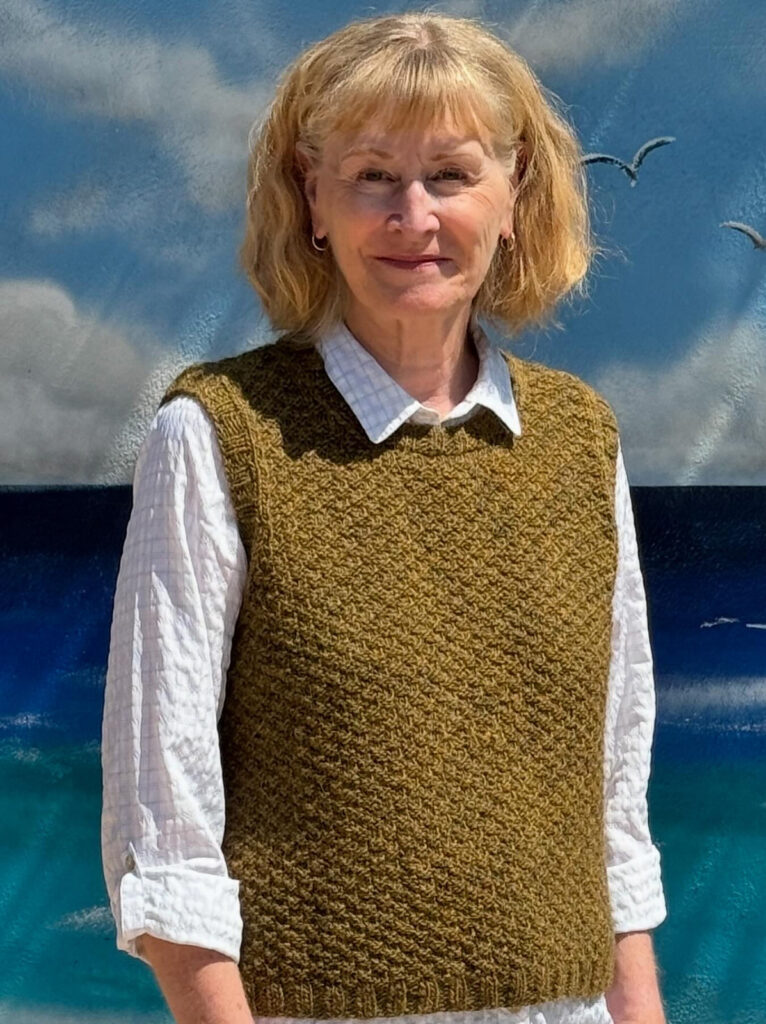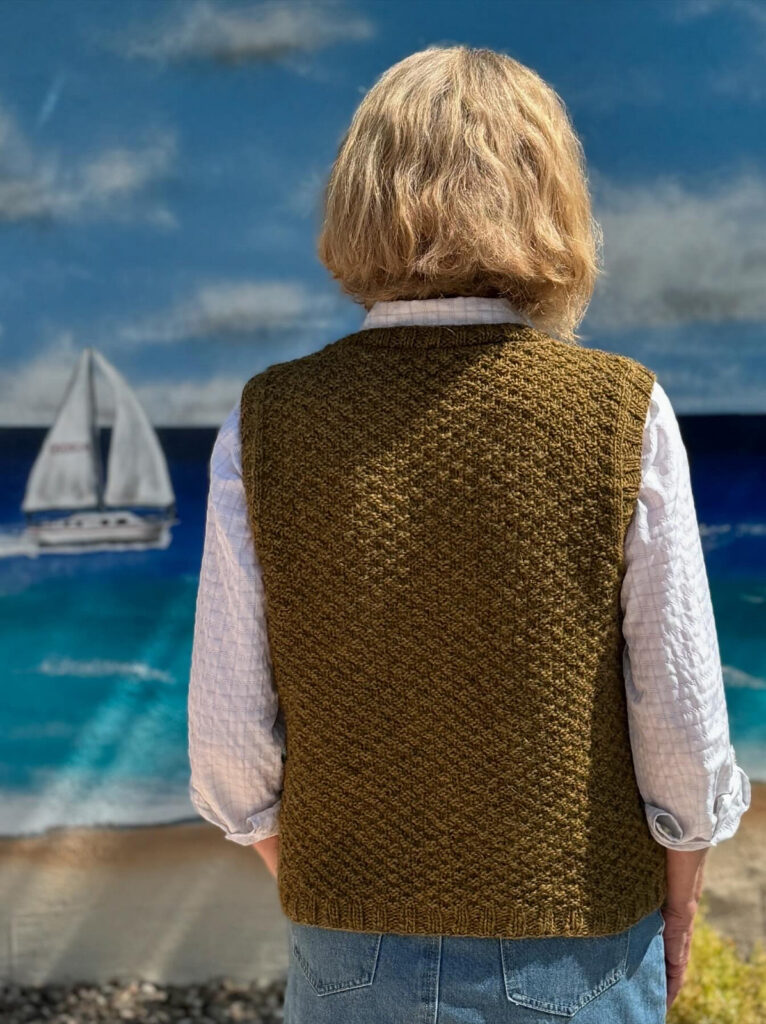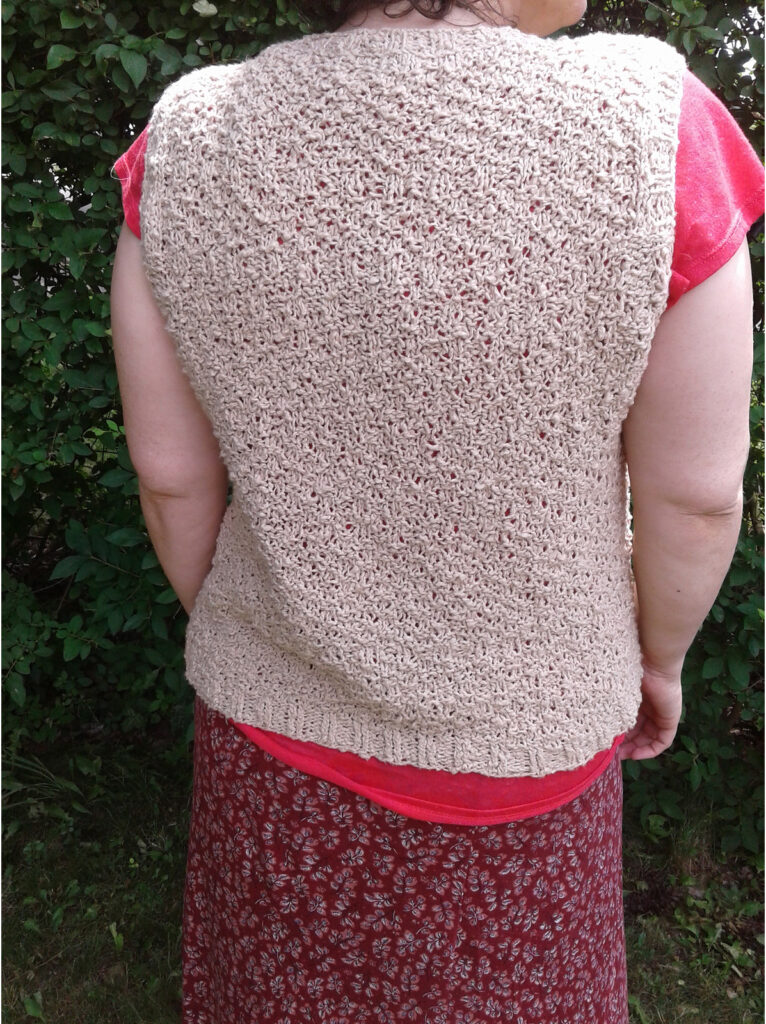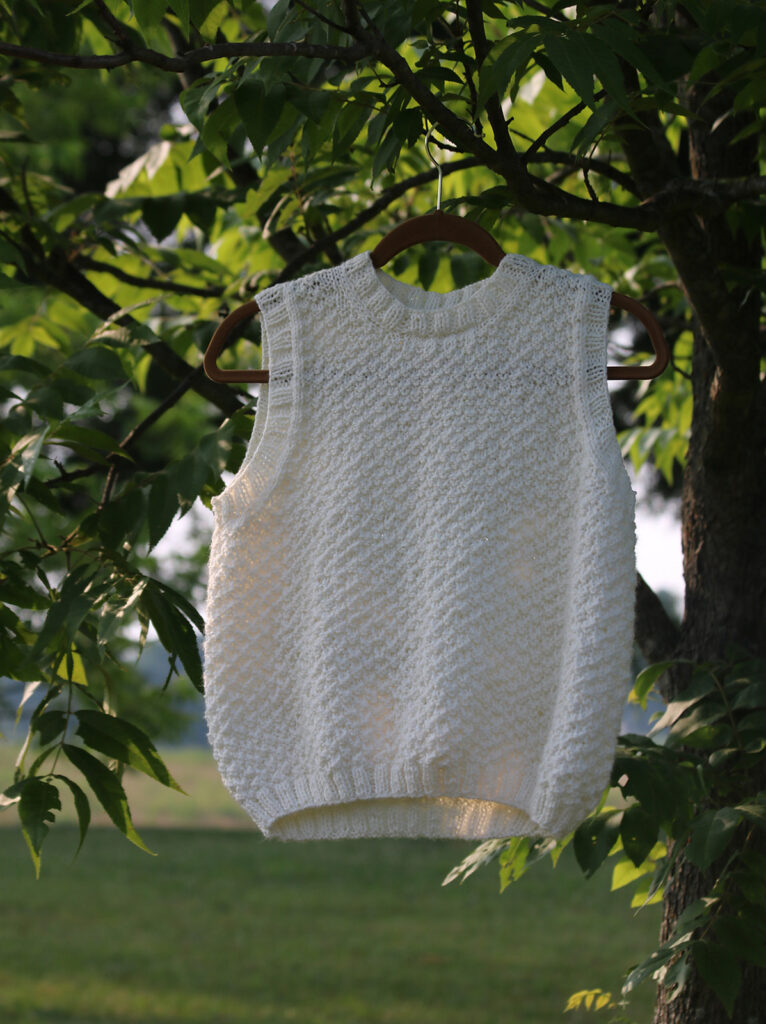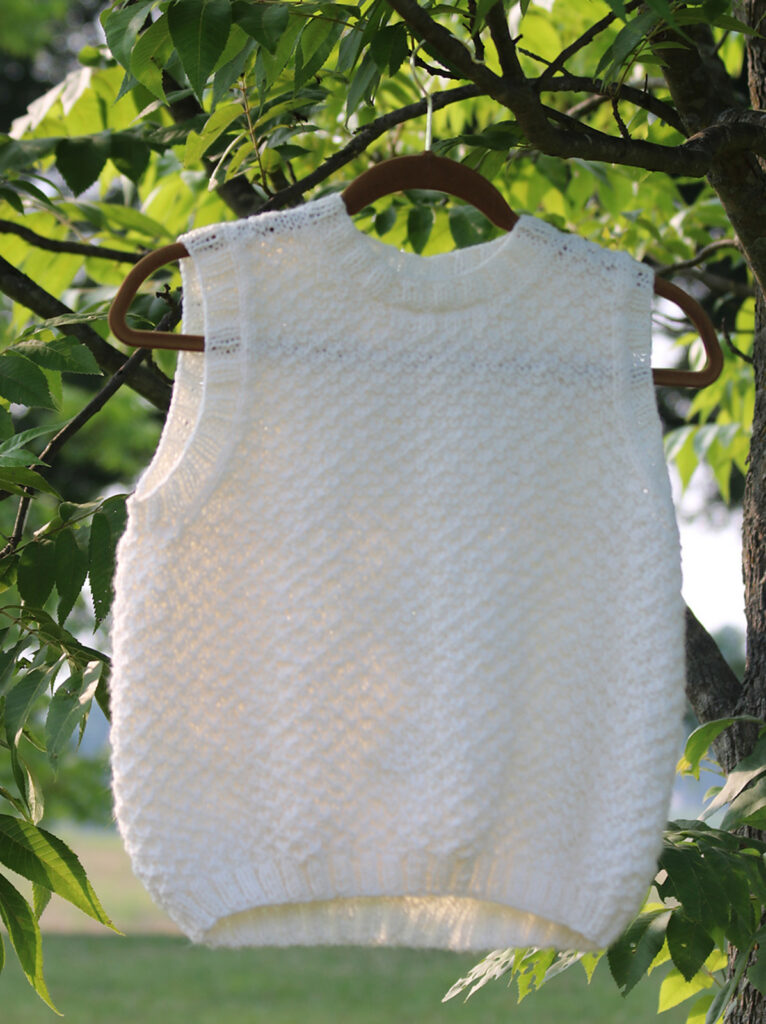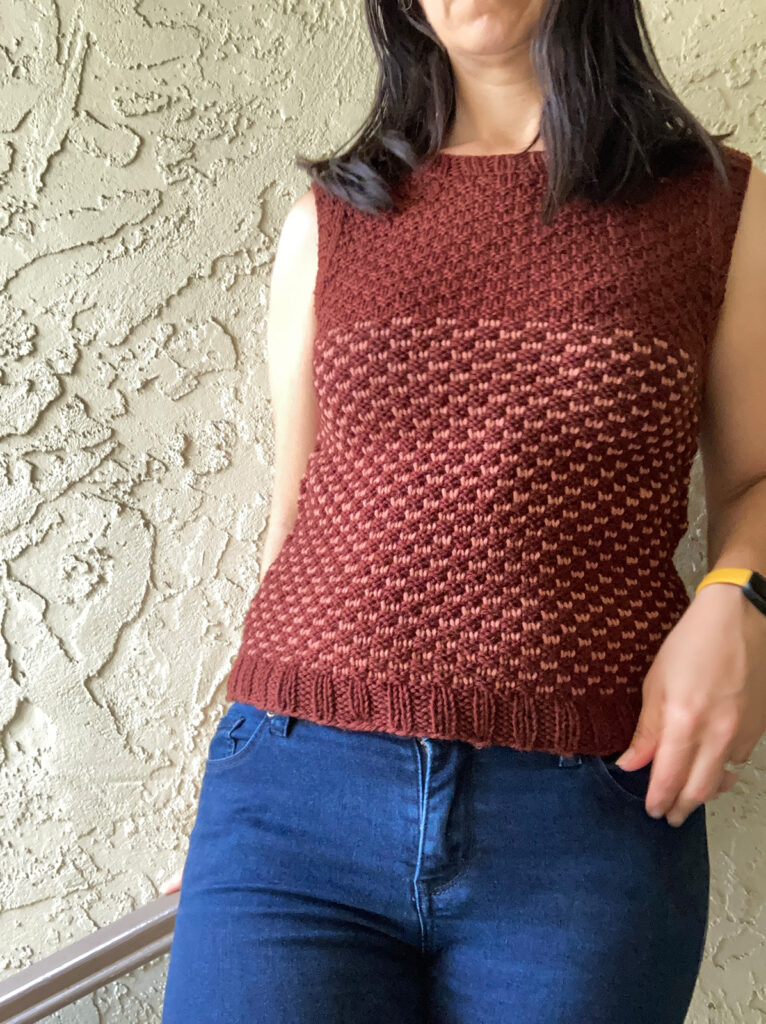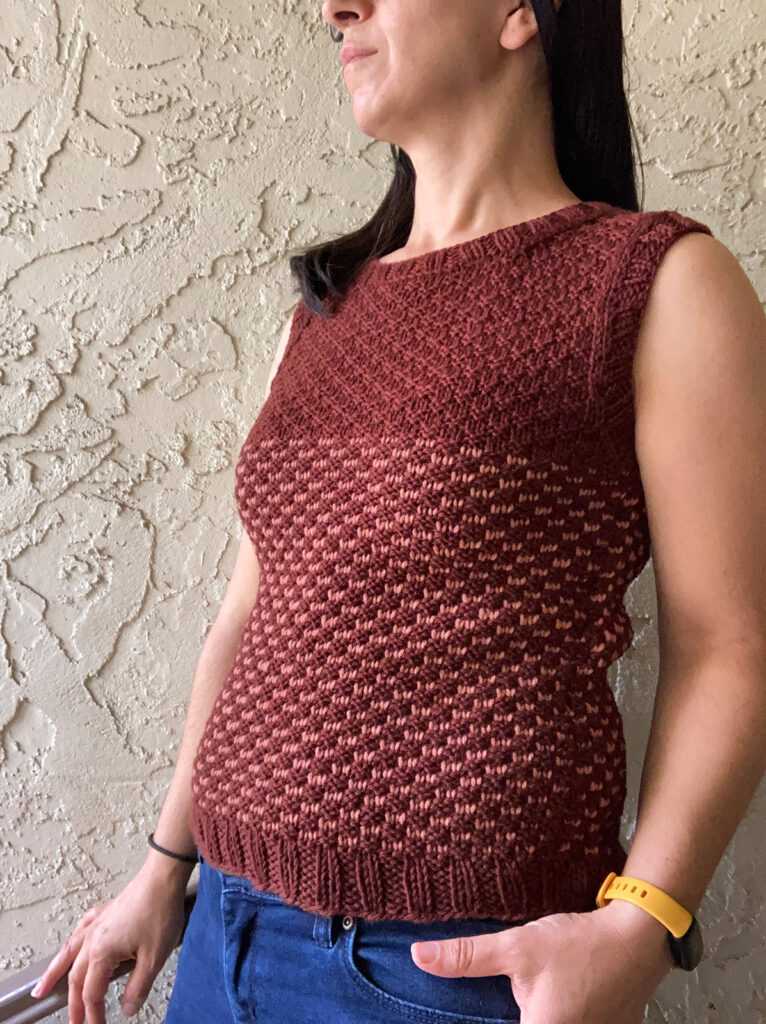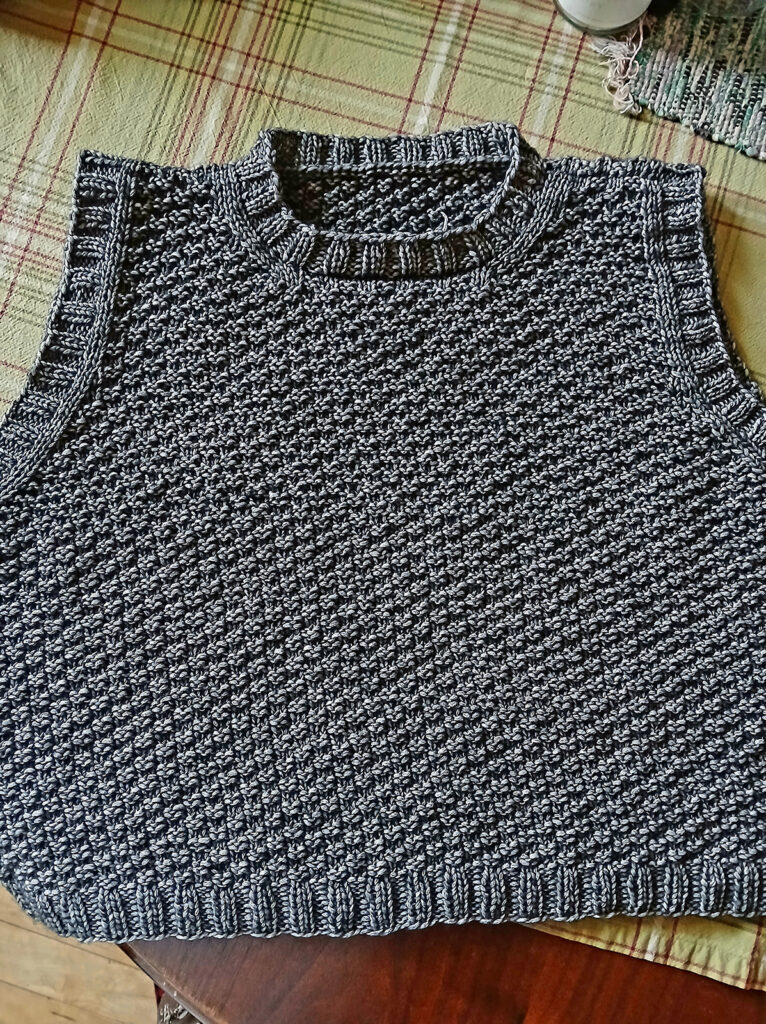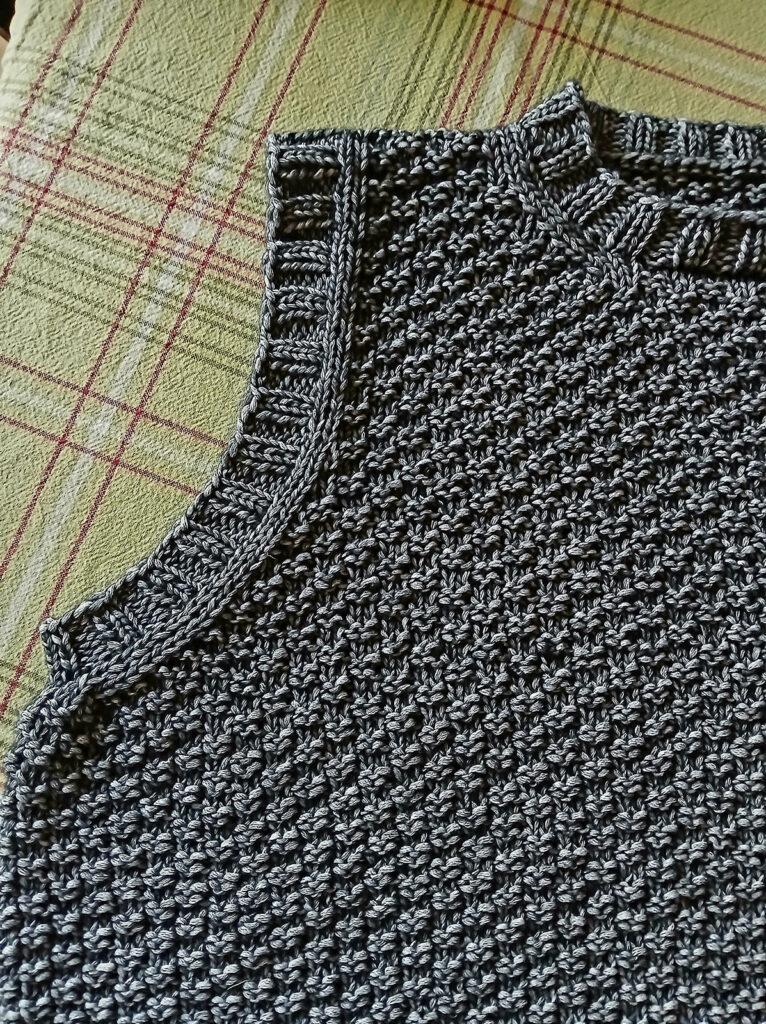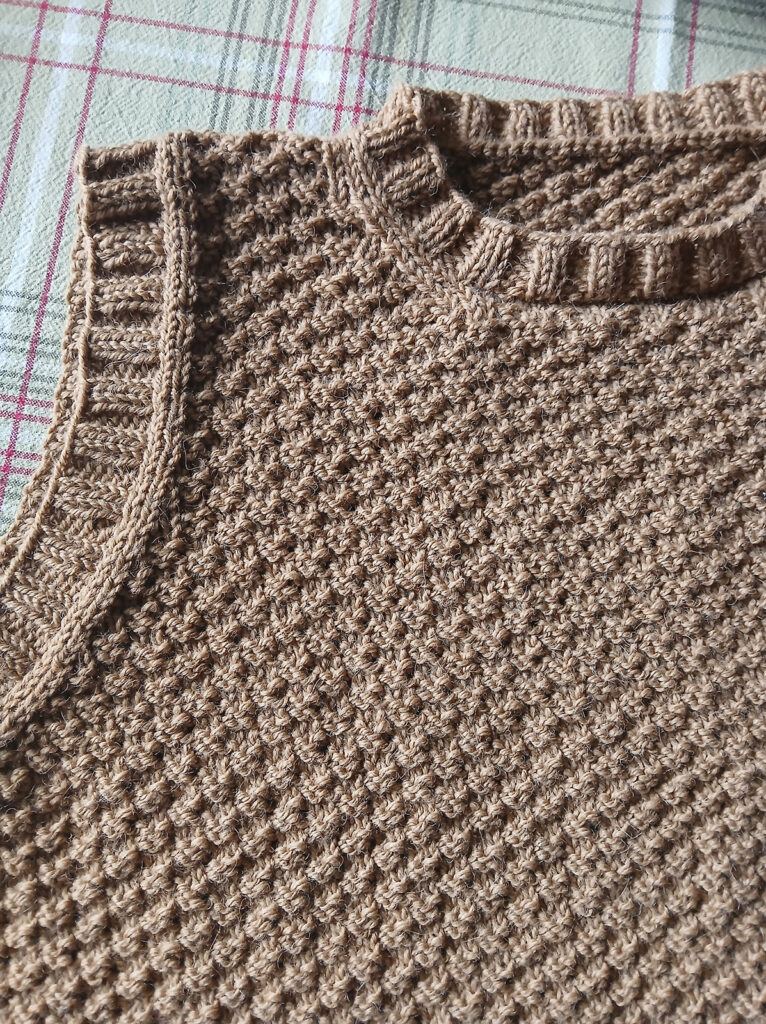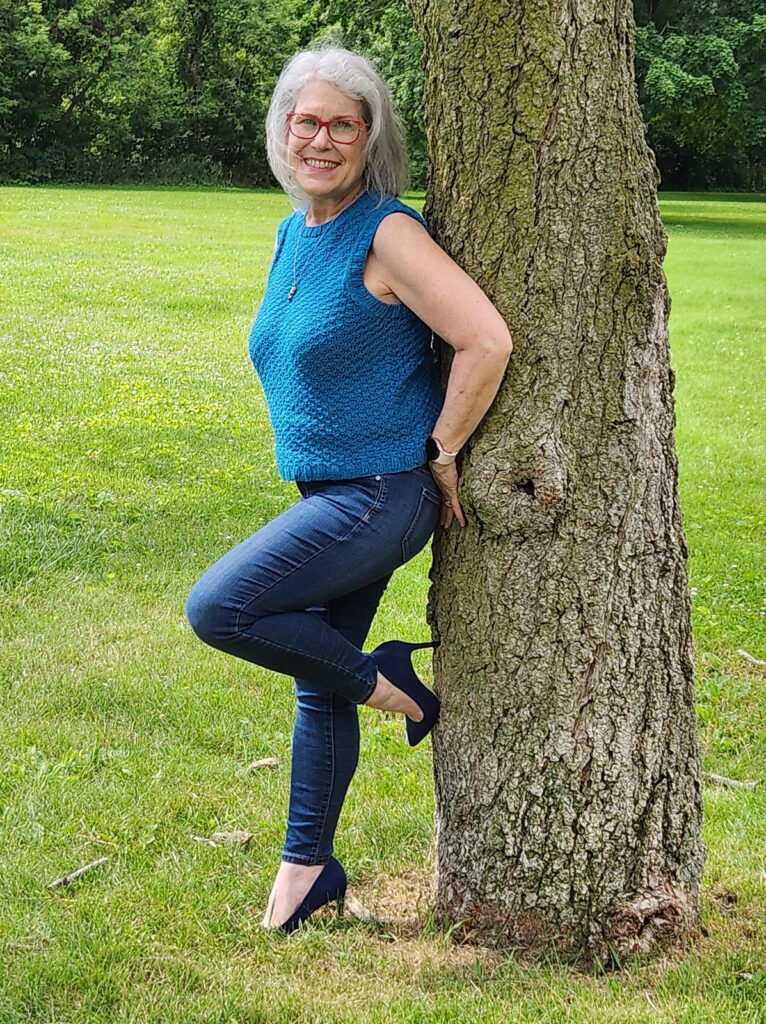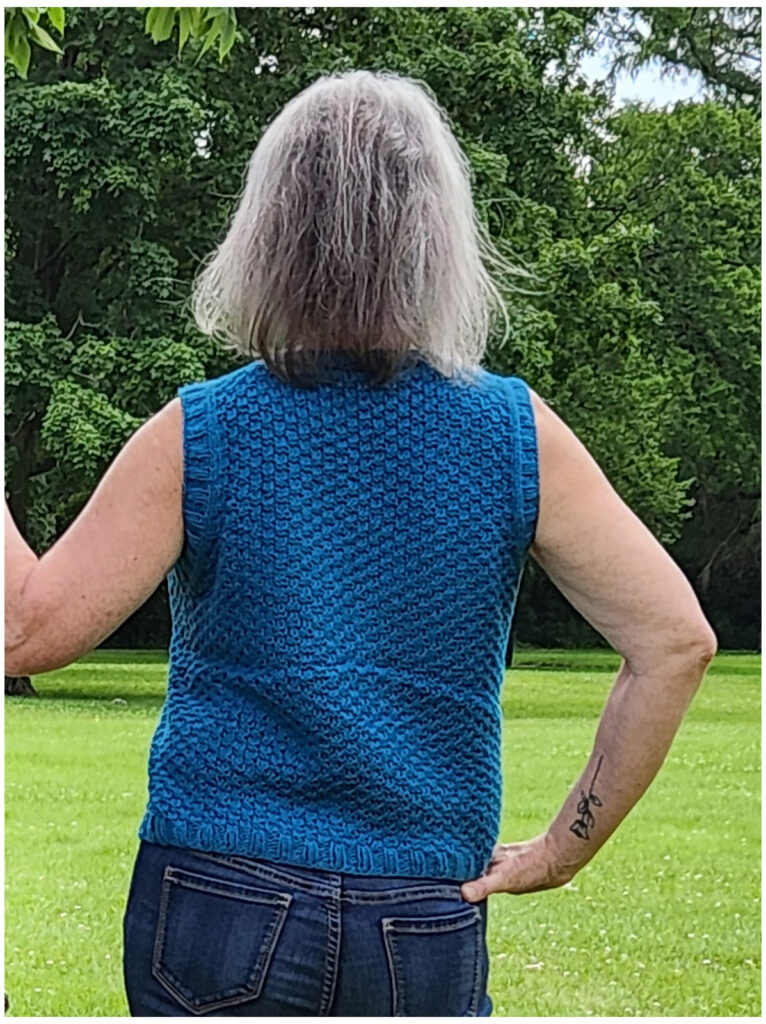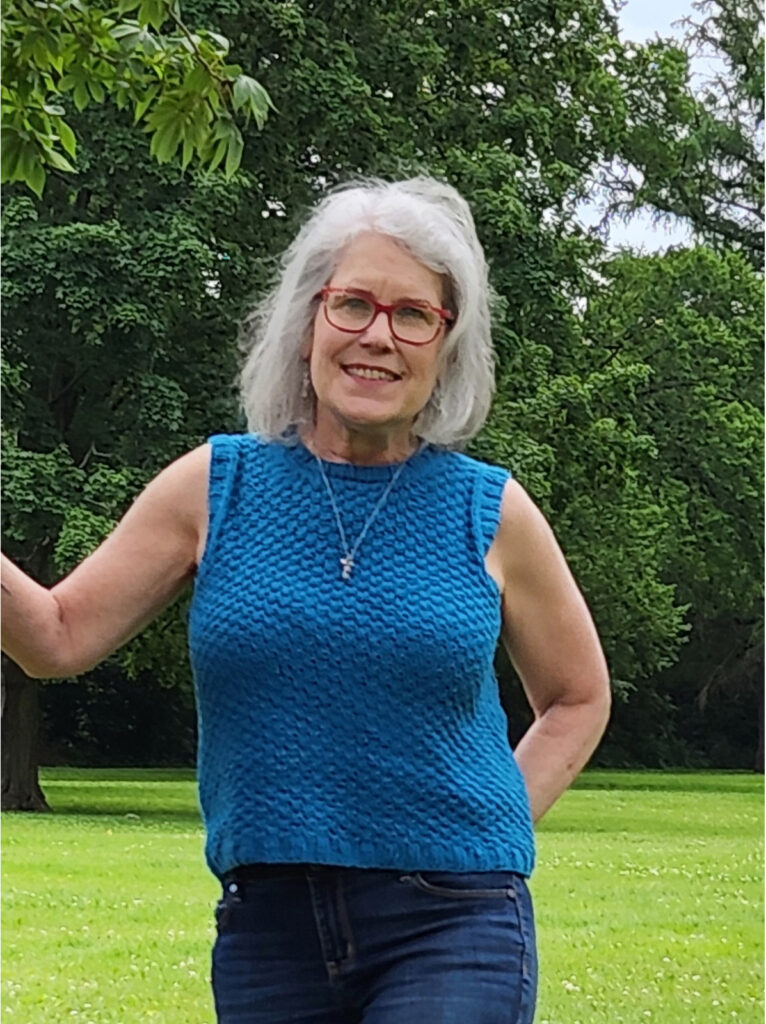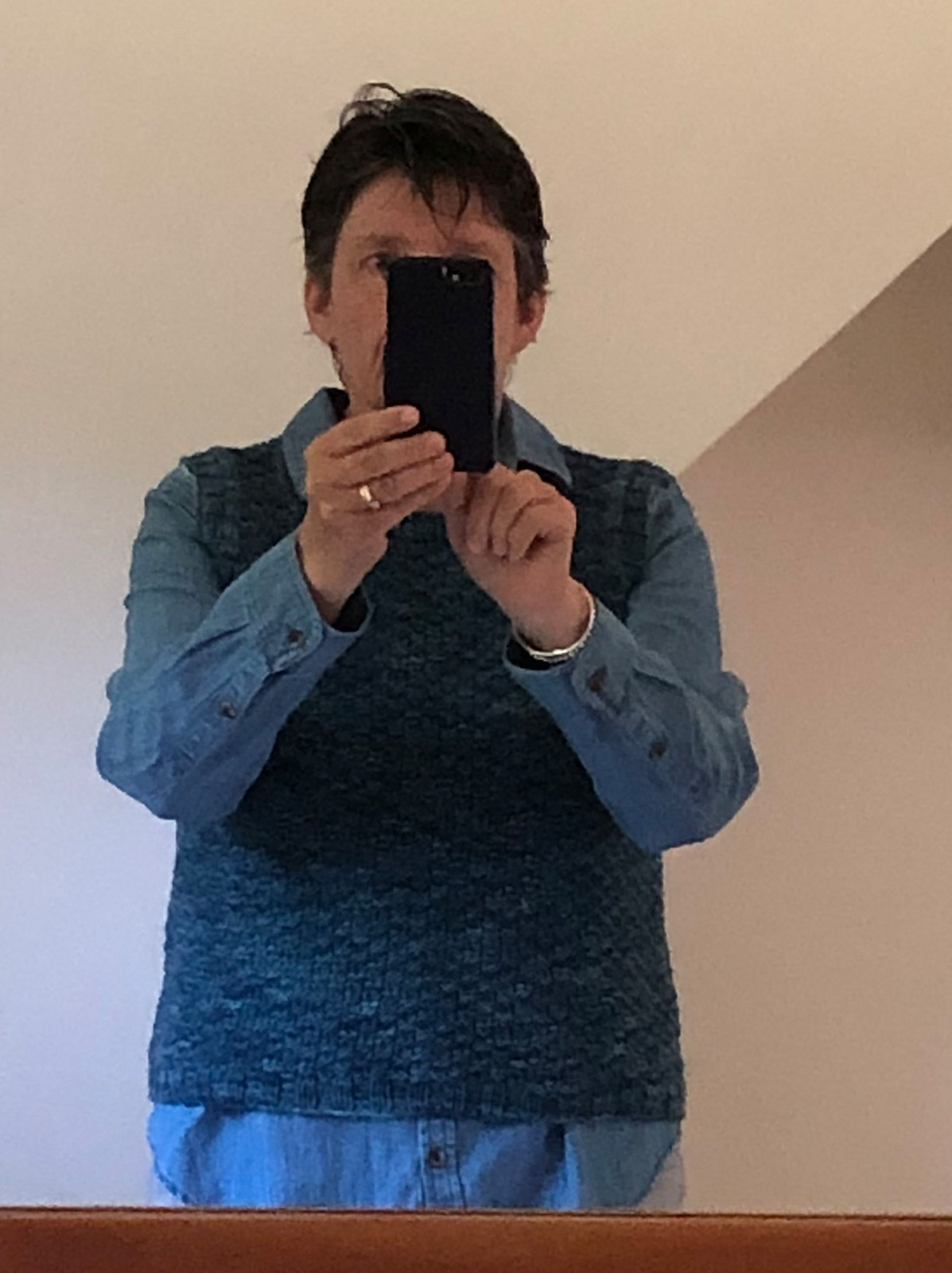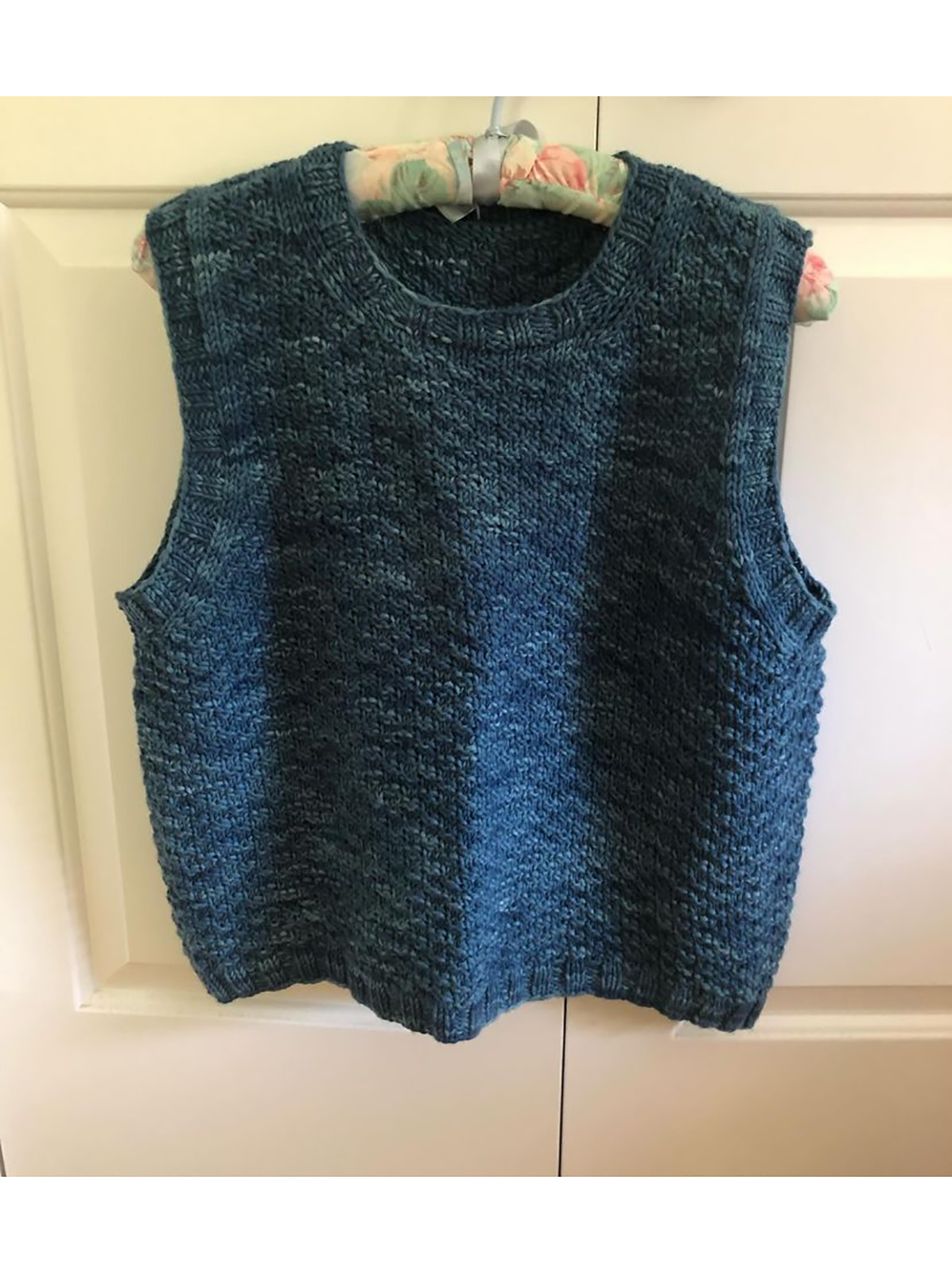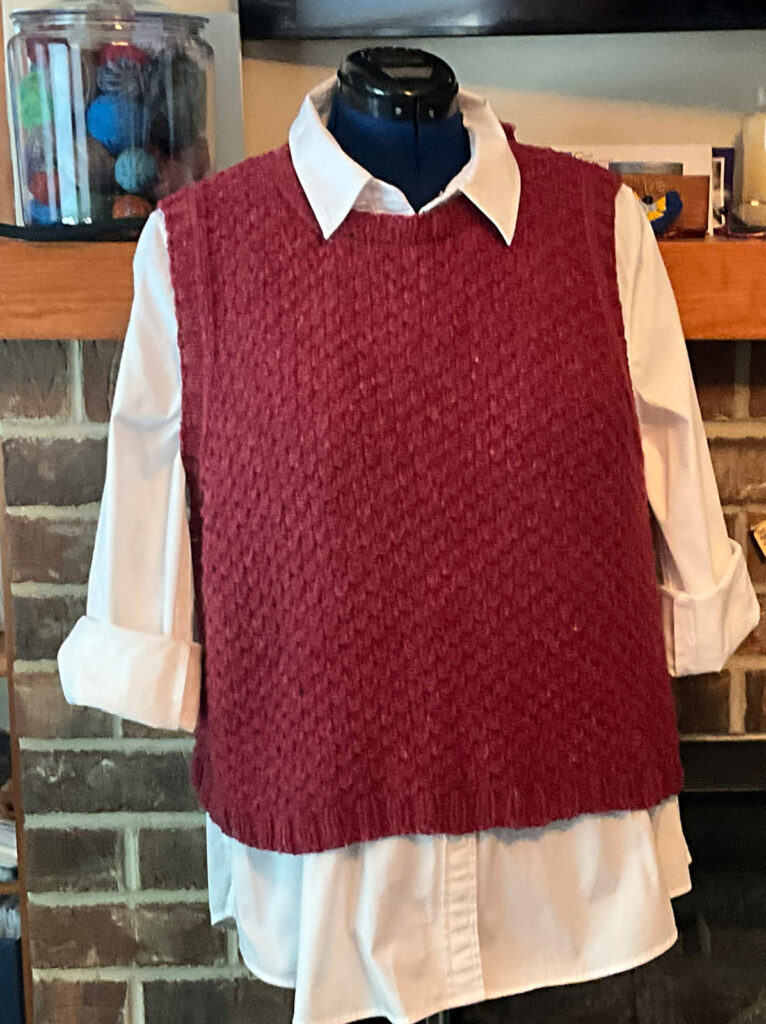I’m excited to tell you about a brand new design of mine that I just published today! Introducing Wharf Street, a worsted-weight, seamless pullover vest featuring a textured ‘box stitch’ patterning. This piece has been in the works since last December so I’m thrilled to finally have it ready for you knit up 🙂 Before I dive into the story behind the design, let me give you a few main details about the new pattern:
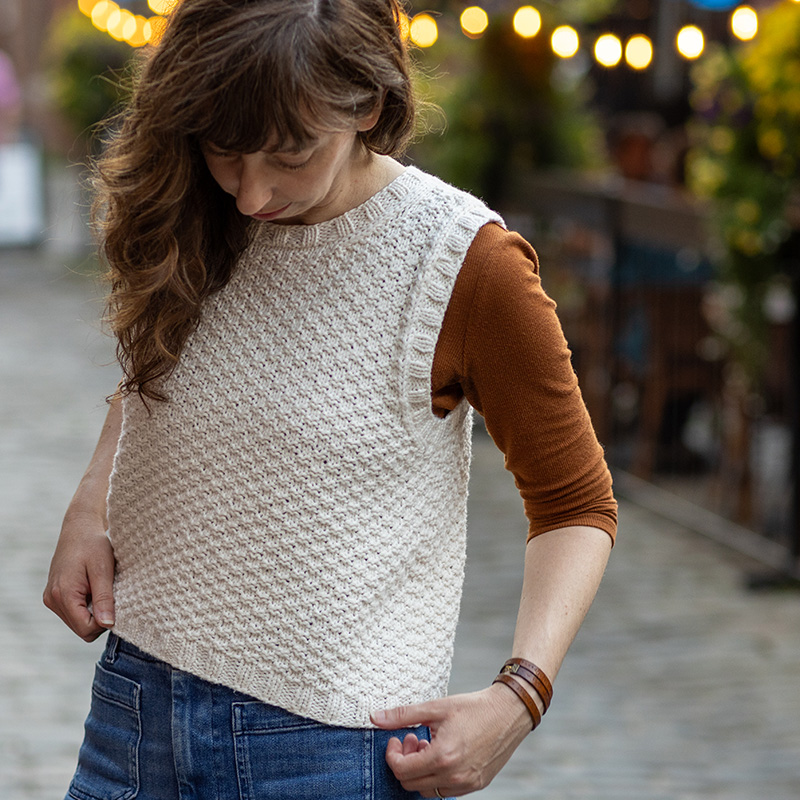
Knit all in one-piece
Wharf Street is worked seamlessly and all in one piece from the bottom-up. It’s worked in the round to the underarms and then the front/back are worked flat up to the shoulders.
Easy but interesting stitch pattern
It features a box stitch that is created just with knits and purls. Plus I have created several photo tutorials to help you ‘read your knitting’ with this stitch pattern for an easy knitting experience.
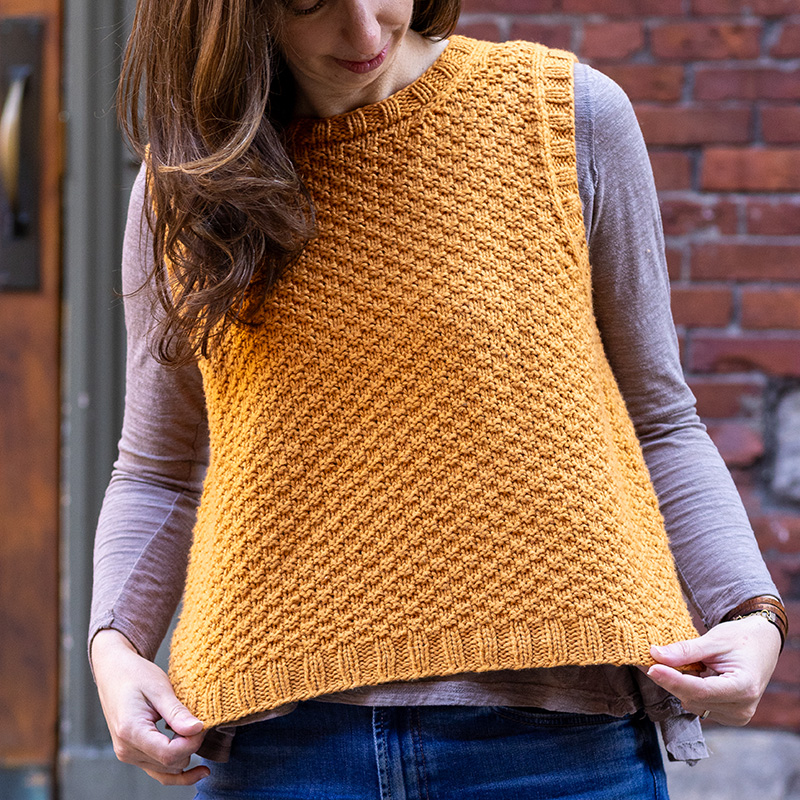
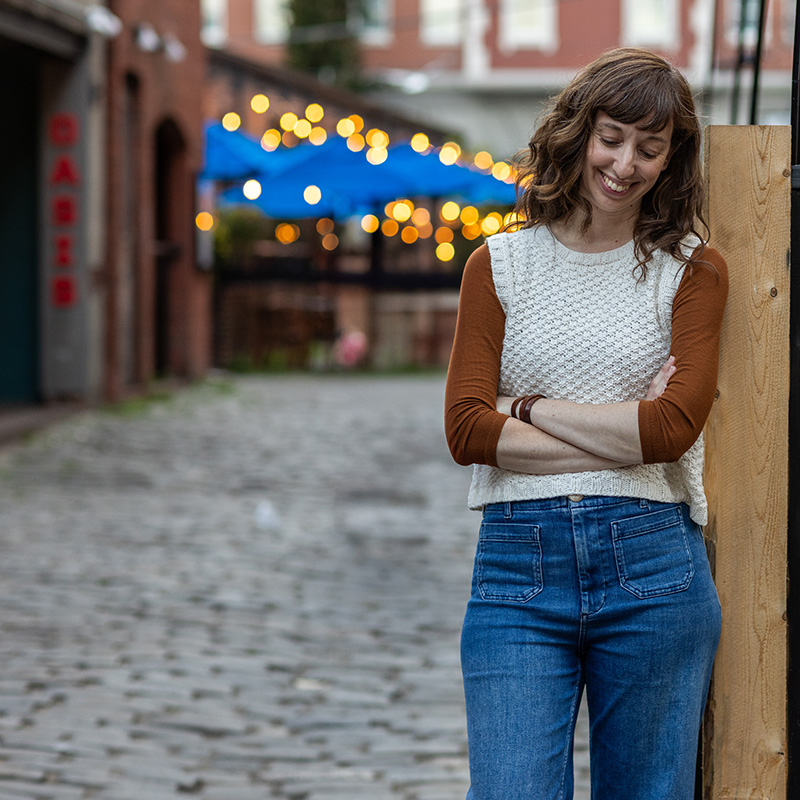
10 sizes to pick from
There are 10 sizes to pick from, ranging in finished circumference of 33″ to 69″. I suggest picking a size that is 4-9″ larger than your actual bust circumference, depending on your desired fit. I’m wearing the white version with 4″ of ease and the orange version with 8″ of ease.
In depth tips page with tutorials
I’ve created a “Wharf Street Tips Page” on my website that answers any question you probably have about this pattern (and then some!). I share tips on picking a size/ease, yarn options, swatching, etc. plus video lessons on picking-up stitches for your armhole and neckline.
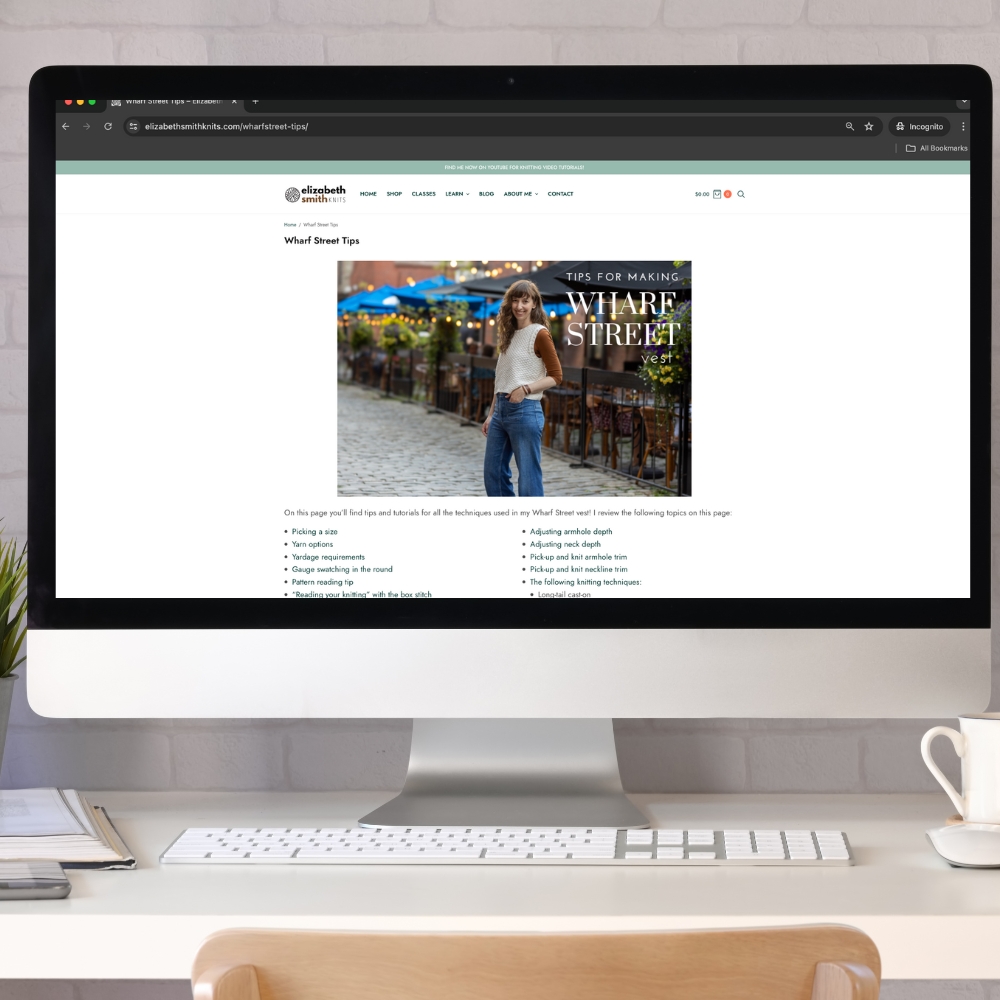
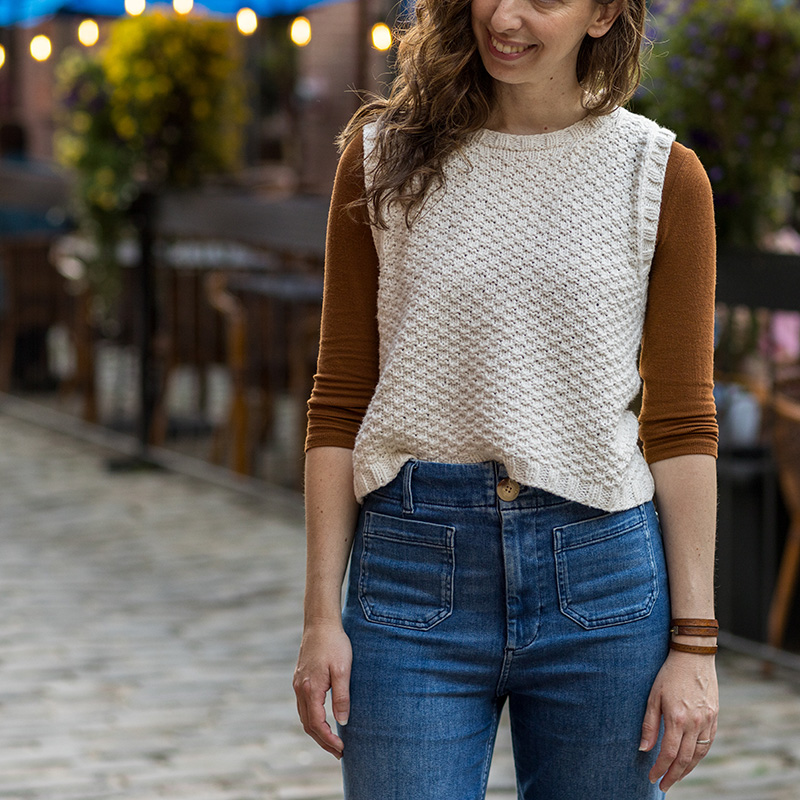
Transitional layer
I knit up both samples of this vest in the cotton/nylon chainette yarn Cumulus by Juniper Moon Farm. Although this is a worsted-weight yarn (and knit on a US 8 needle), the fabric it creates is SO light & airy, making this the perfect light layer to wear in multiple seasons.
Wear it over a tank, 3/4 sleeve, or turtleneck – it’s great in any weather!
Beginner Friendly
Do you consider yourself an intermediate/advanced beginner? Then you can definitely do this vest! I kept the construction and shaping simple to make this an approachable, enjoyable garment knitting experience. Plus my tips page provides tutorials on every technique used.
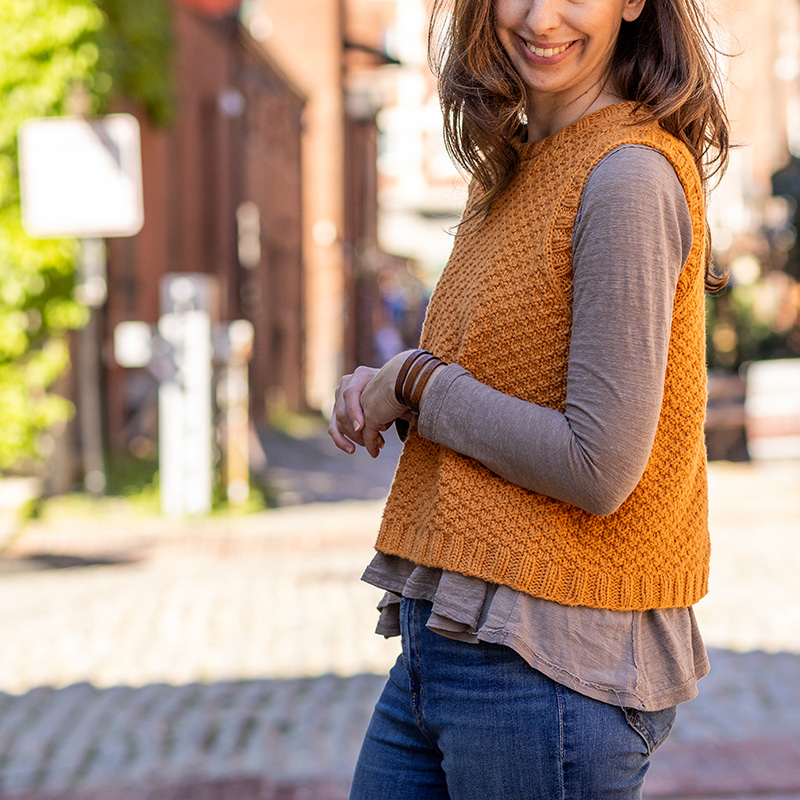
The story behind the design
Now that I’ve shared some of the basics about Wharf Street, here is a bit more of a ‘behind the scenes’ look at my design process, what inspired the name and photos from my wonderful test knitters!
It all started with the yarn…
Sometimes a new design starts with the garment idea and other times it starts with the yarn. In this case, it started with the yarn. I was first introduced to Cumulus by Juniper Moon Farm many years ago when I worked at a LYS, but was reintroduced to it last Spring when visiting a yarn shop out of state. Why did it pique my interest? As you may know, I’m all about styling with layers. So I’m always intrigued with yarns that may make for great light layering garments in different seasons. And so when I saw that Cumulus was not only made of cotton and nylon but also had that chainette-like construction, I thought it might make a great multi-seasonal fabric.
So I did lots of swatching and I really loved working with it! Cotton can sometimes be hard on the hands and it can also feel heavy, especially when it’s worsted-weight or thicker. But Cumulus solves both of those problems – it feels velvety soft and the nylon provides some elasticity (so it’s easier on the hands) and it’s chainette-like construction keeps it light & airy. I worked with a bunch of different stitch patterns but the one I loved the most was the “box stitch” (or sometimes referred to as double moss) – a basektweave-type pattern that, especially in the Cumulus yarn, had amazing stitch definition.
If you would like to use this yarn, check with your LYS if they carry it! I’ve also pasted a few online shops below that currently carry it:
Note: if wool is more your thing, don’t worry – this stitch pattern and overall design works well with any type of yarn! I share lots of tips and swatch photos of other yarns on my tips page if you would like to see.
The design
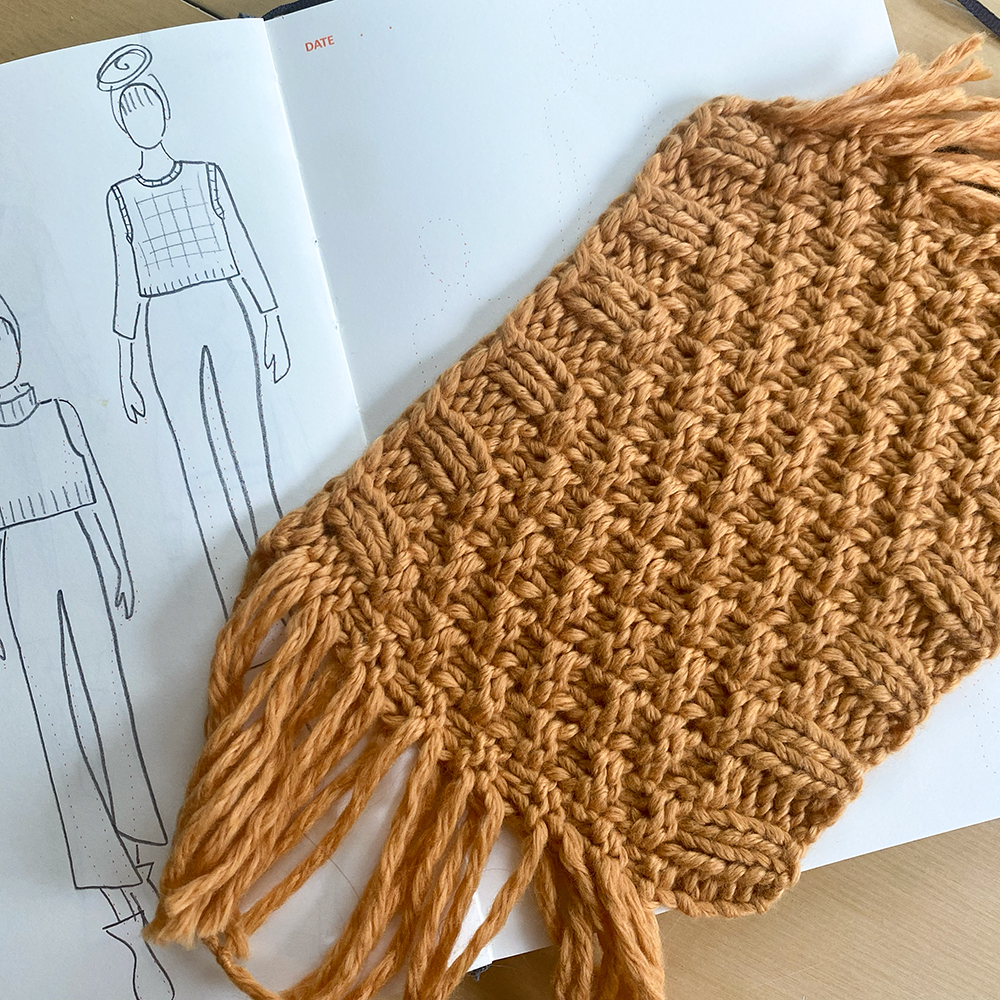
So once I decided on the stitch pattern, it was now time to refine the garment idea. I felt that a vest design would be a perfect match for the stitch pattern. I love designing (and wearing) vests, and I realized I actually didn’t have many pullover-style shaped-armhole vests in my portfolio (Low-Key really being my only other one in recent years).
I loved the idea of using this stitch pattern all over because it created such a nice, interesting texture. But the key was on how to incorporate shaping with the stitch pattern while still keeping the pattern easy to knit. In every design I create, I always strive to keep things simple and tailored towards more beginner knitters or those who just enjoy working on simple, relaxing projects. Designing and writing simple patterns is actually a bit more challenging than you may think! The end product may be simple, but often figuring out simple ways to achieve certain results (in 10 different sizes) is an exercise in not only problem-solving but a lot of trial and error!
This is why I started this design process last December and here we are in August 🙂 But it’s well worth the time and effort because I feel that the pattern is now easy to follow and the finished garment is how I envisioned as well. Here was a day-in-the-life snapshot of my work station as I was mapping and plotting out the shaping for each of the 10 sizes of this vest in Excel:
The pattern name
Once my first prototype was complete and I was thinking about pattern name ideas, the all-over textured stitch pattern reminded me of cobblestones. We have quite a bit of cobblestone streets here in Maine, but the most famous is probably “Wharf Street” located in Portland. It’s located right in the heart of the Old Port and has always been a hub of activity with the restaurants and bars lining each side of it. So of course I thought “Wharf Street” would be the perfect name for it! And since we live just 25 minutes or so away from Portland, we could also do a photoshoot right there.
I thought it would also be great to name it after a Portland, Maine landmark because this August officially marks 20 years since Jeff and I first moved to Maine, and we lived in downtown Portland our first year. Below is an old photo Jeff took of me when we first moved here in 2004 (and yes, I dyed my hair blond back in my 20’s!)…
So back to the Wharf Street vest! Let me share some fun ‘behind-the-scenes’ stories about both of these vest photoshoots. We first shot the orange version and we went to Wharf Street around 9am. We had looked at the forecast earlier in the week and that morning was going to be the first day that the humidity was finally going to break (it’s been very hot & humid this Summer here in Maine!). Since I wanted to style the orange version under a long-sleeved tee I thought “perfect – let’s do it then!”. One thing we didn’t check though was the wind gust forecast. Being right on the coast, Portland is almost always windy but that particular morning it was VERY windy! So although we managed to get some shots in-between the gusts, most of our photos looked like this:
Oh well, we made it work anyway! Then a few weeks later we went back to shoot the white version but this time we went just before sunset (“golden hour”). As you can see when comparing the photos, it’s so interesting how the time of day really impacts the overall light/color isn’t it? The added bonus of the evening photoshoot was that the restaurants had their outdoor lights on so we got that nice blurry light affect in the background. And the wind was less gusty so that was an extra bonus too! The trickiest part was shooting in-between crowds of people walking by – it’s peak tourist season and so this time of day brings lots of people to Wharf Street. So it took over an hour of us hanging around and then waiting for breaks in the crowds!
The test knitting
I had several wonderful test knitters who previewed the pattern for me over the last couple of months and I’m so thankful for their participating, feedback and finished photos as well! (note: if you’re interested in being a test knitter for future projects, check out my page here).
Denise
Denise knit her vest in Cumulus as well and is wearing with 3″ of positive ease.
Susan
Susan knit hers in Léttlopi and is wearing with 8″ of positive ease.
Elizabeth
Elizabeth used the textured yarn Patons North America Cotton Top.
Tamiko
Tamiko also used Cumulus by Juniper Moon Farm.
Nari
Nari used Lark by Quince & Co, and for the body used a contrasting color every 2 rounds. She is wearing with 1-2″ of positive ease.
Kari
Kari made 2 versions – the gray/black is Cascade Yarns Cantata Solids and the orange is Berroco Ultra Alpaca. She will be wearing with 6″ of positive ease.
Denise
Denise also used Cumulus by Juniper Moon Farm and is wearing with 4″ of positive ease.
Lee
Lee knit her Cumulus in Plymouth Yarn Worsted Merino Superwash Kettle Dyed.
Karen
Karen knit her vest with Berroco Remix and will be wearing with 9″ of positive ease.
I hope you’ve enjoyed learning about the Wharf Street Vest as well as hearing about some of the ‘behind the scenes’ aspects of the design’s creation. If you would like to knit your own Wharf Street vest, click here for the pattern info page here on my website or here for Ravelry.

